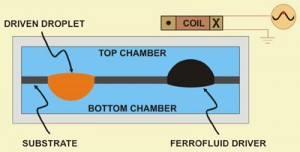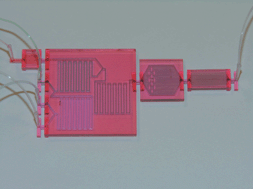US researchers have used ferrofluids as liquid pistons that could be used to make adjustable liquid lenses with nearly perfect spherical interfaces for applications such as an optometrist’s phoropter. A phoropter measures the way light is focused in the eye and is used to determine prescriptions for glasses and contact lenses.
Ferrofluids are colloidal solutions of ferromagnetic nanoparticles suspended in a dispersing liquid. Ferrofluid droplets can be manipulated by a magnetic field, so they could be used in systems that need precise control, such as optics, drug delivery, and electronic devices.
Amir Hirsa and colleagues from Rensselaer Polytechnic Institute in Troy, New York, have made such a device by filling three of four holes in a substrate with ferrofluid; the ferrofluid’s surface tension allows droplets to protrude from either side of the substrate. They filled the fourth hole with 1-methylnaphthalene, a compound used as a liquid lens. They sealed the system and filled it with water, producing two chambers, with the substrate as the separator and the ferrofluid and 1-methylnaphthalene being the only connections between them.

As a magnetic field was applied to the device, the ferrofluid moved further into one chamber, pushing the 1-methylnaphthalene liquid lens and changing its curvature
Read the full story here
Link to journal article
Electromagnetic liquid pistons for capillarity-based pumping
Bernard A. Malouin Jr, Michael J. Vogel, Joseph D. Olles, Lili Cheng and Amir H. Hirsa,
Lab Chip, 2011, DOI: 10.1039/c0lc00397b














